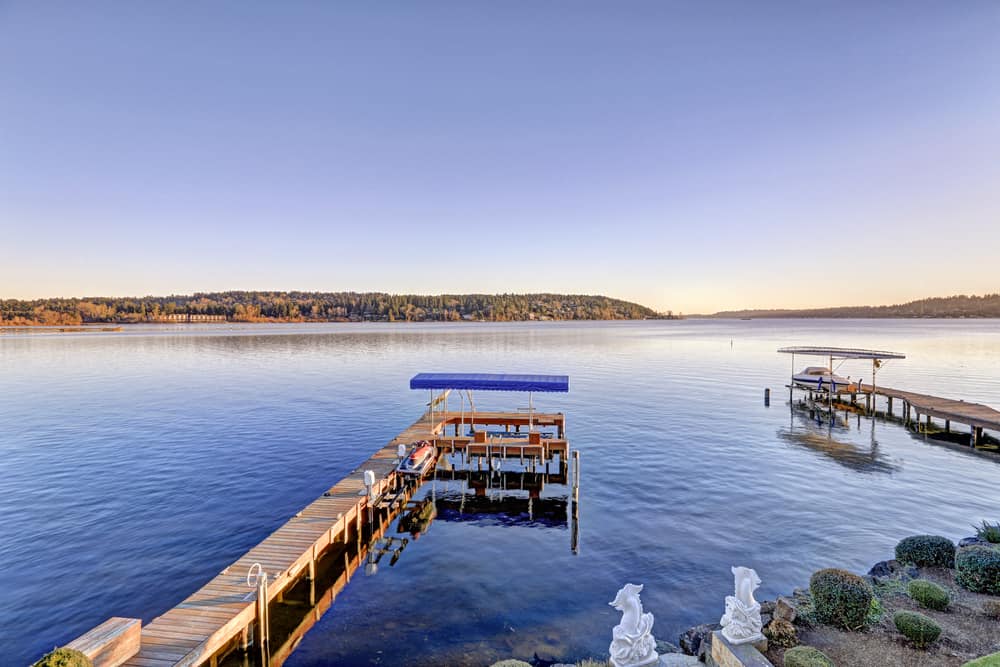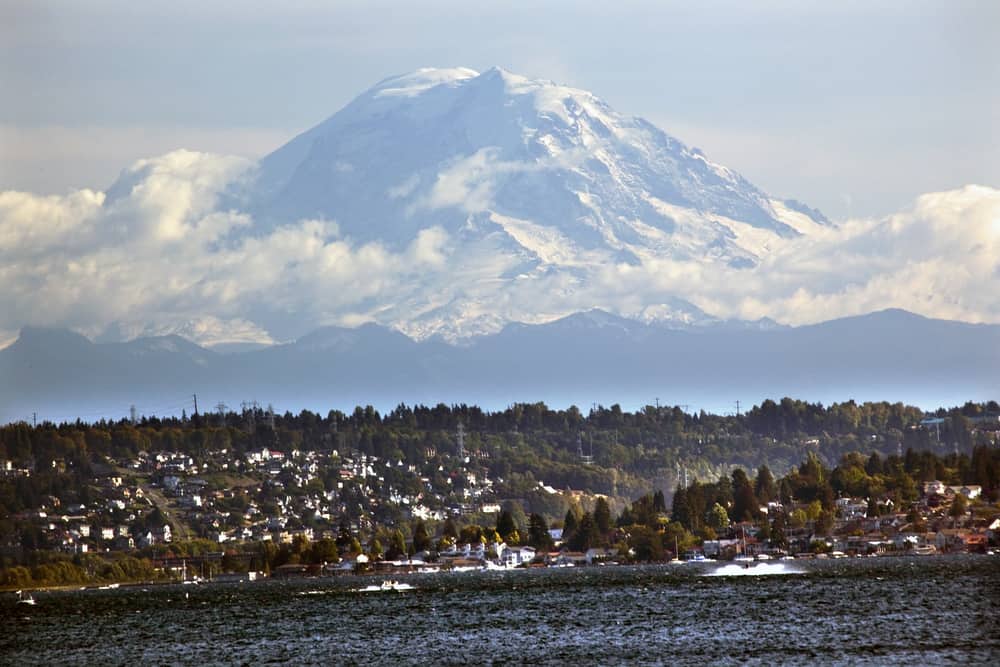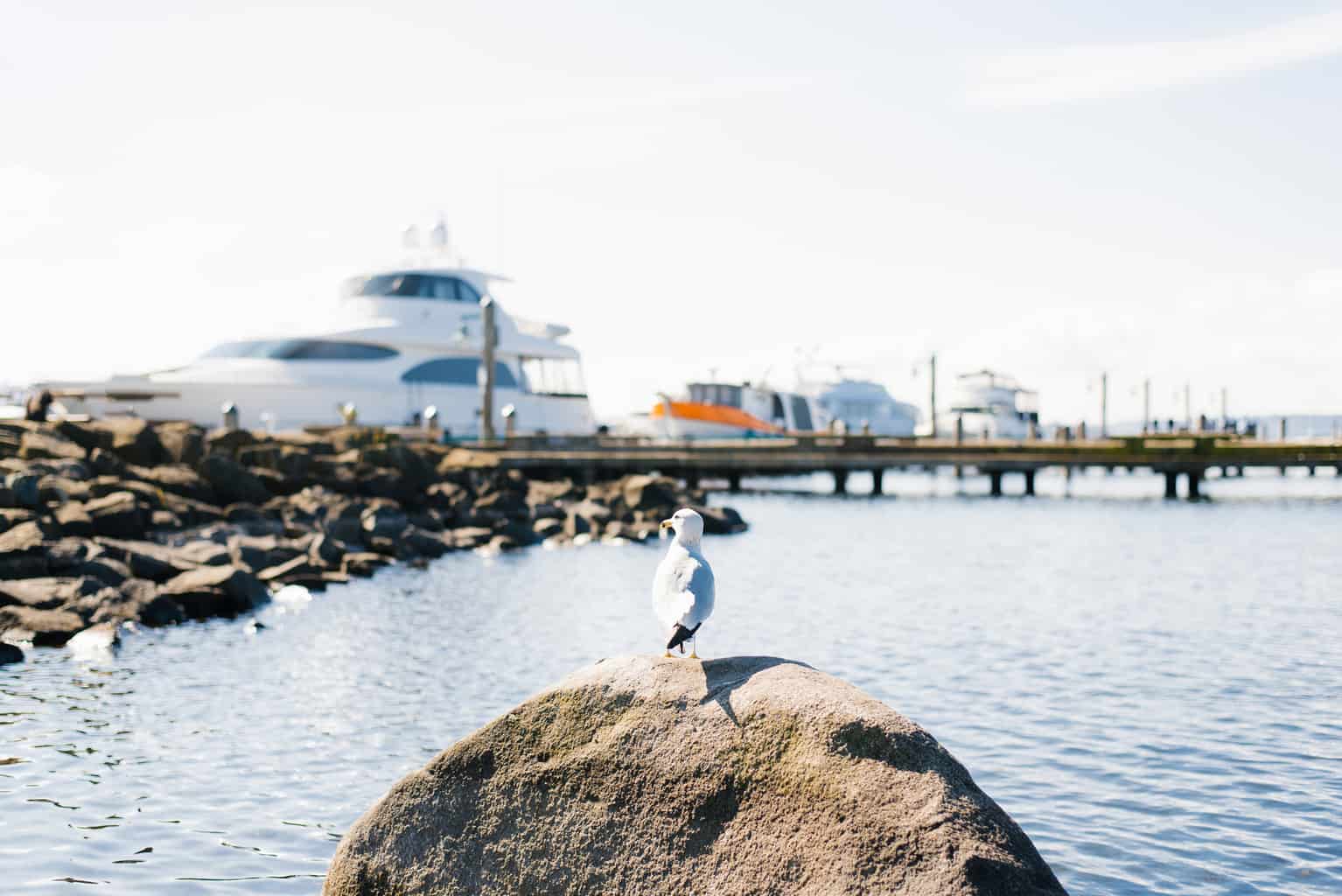The state of Washington’s second-largest natural lake at 34 square miles, Lake Washington east of Seattle offers outstanding fishing opportunities, with more kinds of fish than most bodies of water in the Pacific Northwest can match.
Lake Washington separates Seattle from many of its largest suburbs, including Bellevue, Redmond and Kirkland. Mercer Island, a city in its own right, covers the island of the same name in the middle of the lake.
The largest lake in western Washington, it has nearly 60 miles of shoreline and innumerable access points, with fishing piers and boat docks on all sides.
Among them, the city of Kenmore and the Washington Department of Fish and Wildlife jointly maintain a concrete boat launch near the north end of the lake, where the Sammamish River flows into it from Lake Sammamish to the east.
Chumming is permitted but two-pole fishing is not allowed for Lake Washington fishing.
While Lake Washington offers many fish to catch, the lake does suffer from urban and industrial pollution.
State authorities advise limiting your consumption of a few of the fish species caught from Lake Washington due to PCB contamination, although certain quantities are considered safe for people to eat. (See Washington’s fish consumption advisories.)
Trout Fishing
While it’s not stocked with hatchery-reared trout, Lake Washington supports a huge population of resident coastal cutthroat trout. Some of these move in and out of the Cedar River, a tributary stream on the south end known for excellent fly fishing.
Wild trout are often prized above hatchery fish for eating since they are born and grow to maturity in a natural habitat where they can swim freely and feed on a natural diet. They are also more challenging as game fish.
Lake Washington is one of the best lakes to catch larger cutthroat trout in Western Washington.
When to Catch Cutthroat Trout
At Lake Washington, cutthroat trout can be caught year-round, although spring and fall are the best times of the year if you’re looking for potentially excellent trout fishing. Winter can be quite good as well when you find a break in the weather.
Early spring through June and October through December typically offer good prospects. The time of year definitely will influence your success rates if you’re looking to catch fish, as water temperatures can run a little high for trout metabolisms in mid-summer and low in mid-winter.
Cutthroat trout tend to be at their most active when temperatures aren’t too warm. They’ll often feed in the shallows on spring and fall days, while they’re less active and spend more of their time in the depths during the summer and winter.
How to Catch Cutthroat Trout
Adjust your fishing technique accordingly. Trolling is effective for covering this big water, fishing deeper when the trout move down in the water column.
Still-fishing with bait or casting lures or flies are other options.
For more ideas to help you catch these fish, read Trout Fishing: Basic How-To Techniques and Tips.
Although less common, anglers may also encounter hatchery steelhead (ocean-run rainbow trout) at Lake Washington. If you do reel in any steelhead between the months of July and November, you must release it; rainbow trout larger than 20 inches must be released from December through June.
Don’t eat too much cutthroat trout from Lake Washington.
The state of Washington advises making a meal of a trout larger than 12 inches just once per month at most, or three times per month for smaller trout, due to elevated PCB levels detected in fish taken from the lake.
Salmon Fishing
Lake Washington has two types of salmon that anglers can catch each year.
These include migratory coho salmon that run up from Puget Sound, through Ballard Locks, and up through the lake, and they can be quite large. Kokanee (landlocked sockeye salmon) spend their entire lives in freshwater and tend to be closer to typical trout in size.
Coho Salmon
Lake Washington has a short coho season, with anglers permitted to take up to four per day from Sept. 16 through Oct. 31, when the larger fish return from the ocean.
Coho, sometimes called silver salmon, are big fish that can top 30 inches in length.
At Lake Washington, it’s not permitted to take a coho smaller than 12 inches, as those smaller fish have not yet migrated to the ocean to grow to maturity.
The coho limit applies north of the Highway 520 bridge and includes the lower portion of the Sammamish River.
Fishing for coho isn’t exactly like fishing for trout, although trout and salmon are related species. Adult coho are bigger, stronger and at times have a bigger chip on their shoulders.
Many anglers agree the best way to fish for sometimes-aggressive coho is to agitate them into attacking.
Casting or trolling lures such as spinners or twitching jigs can make coho charge like an angry bull, although coho in freshwater are maddeningly inconsistent biters.
If you’re angling for salmon, make sure your equipment is up to the task. You’ll likely need a stronger line than you might use for trout or bass fishing, as well as a rod with enough backbone to land fish up to and beyond 10 pounds. If you have steelhead gear, that’s likely to do the job.
Rubber nets are highly recommended for fish you might end up releasing.
We have a bunch more salmon fishing techniques and tips.
Kokanee
Kokanee also inhabit Lake Washington, although they are not stocked in the lake proper. Although sometimes called silver trout, kokanee are actually salmon — sockeye salmon, to be exact — that never migrate to the ocean.
The best fishing for kokanee salmon comes in late spring, when they feast on plankton blooms. In the hot summer, look for kokanee in the deepest parts of the lake.
Early fall can also be a fine time to fish for kokanee, although the larger specimens will begin to prepare for spawning and won’t taste as good.
Year-round, there is a daily limit of five kokanee that can be taken, with minimum and maximum size rules also applying to help protect their ocean-going cousins.
On Lake Washington, kokanee longer than 18 inches or shorter than 8 inches cannot be retained. Most of the keepers are pan-sized fish.
However, don’t underestimate kokanee. They can put up a spirited fight for their size. They also have very soft mouths that make them tricky to get to the net.
Like coho, kokanee tend to react aggressively to bright and flashy activity in the water. Probably the most popular fishing technique is trolling lures and/or bait behind a set of blades to attract their attention.
A speed of somewhere between 1 and 2 mph is recommended, with the slower end of that range a good place to start. In essence, try to match the speed of the fish.
Learn how to catch more kokanee.
Other Salmon
In a typical season, salmon other than coho and kokanee must be released.
But in a good year for salmon runs on the Sammamish River, ocean-run sockeye and even Chinook salmon fishing may be opened.
Keep an eye on local advisories and check with the Washington Department of Fish and Wildlife for recent updates if you are unsure of the current regulations.
There are no health advisories for salmon, including kokanee, caught at Lake Washington.
Bass Fishing
Lake Washington supports resident populations of both largemouth and smallmouth bass.
While available year-round, the bass season really picks up in April, continuing strong through September or October.
On Lake Washington, May and June are considered the peak months, with fair to good largemouth bass fishing prospects and some of the best smallmouth bass fishing in Washington state.
Largemouth bass are distinguished by their generally larger size and their considerably wider mouths.
These predatory fish will eat pretty much any living thing that can fit in their mouths, such as other fish, crayfish, frogs, and other aquatic inhabitants. Largemouth bass, at least occasionally, will even pick off rodents and ducklings swimming on the surface.
Smallmouth bass, by comparison, generally eat slightly smaller prey, often focusing on crayfish and small fish. They can be extremely aggressive and are hard fighters.
When to Catch Bass
May and June are when Lake Washington bass tend to spawn. They clear nests and aggressively defend them, meaning those are the spots you want to be fishing for the largest bass. There can be some great fishing if you time it right.
You may be able to spot nesting bass, but even if not, if it’s spring try fishing the shallower water around the edges of the lake, and move around if you’re not having much luck in one location.
Chances are good you will encounter bass and, in the process, learn the areas where bass will return year after year to spawn.
We encourage you to catch and release spawning bass to maintain the fishery.
During the summer months in particular, bass may hide out in deeper water or shady areas such as under docks or other cover.
Bass will often hunt in shallower water in the early morning or late evening while the sun is low or gone from the sky, so anglers will have an easier time finding aggressive fish then.
If you see minnows scurrying away from something, there’s a good chance it’s a big bass hunting for food.
How to Catch Bass
Bass jigs and other lures are usually designed to either look like their prey species or to provoke a fast strike from naturally aggressive species. Experiment and see what works best for you.
Broadly speaking, largemouth bass prefer muddier bottoms and aquatic weeds often found in coves, while smallmouths tend to favor harder structures including rocks and sandy bottoms, but both species overlap quite a bit.
For more information about catching bass, read our easy guide, Bass Fishing: Simple How-To Techniques and Tips.
Bass Fishing Regulations
Overall, there’s a daily limit of 10 largemouth bass and 15 smallmouth bass on Lake Washington.
Only one smallmouth bass 14 inches or longer can be retained.
Largemouth bass may be kept if under 12 inches, although you can keep one per day that is over 17 inches long.
If you plan to take and eat your bass, limit your consumption. Because of relatively high PCB concentrations, the state of Washington suggests eating bass caught at Lake Washington no more often than twice a month.
Smaller, younger bass tend to be tastier and may have lower concentrations of toxins.
Perch and Crappie Fishing
Lake Washington also supports populations of smaller schooling fish.
Yellow perch and black crappie are two popular panfish. These fish, most often under 10 inches in length, can be caught year-round and in good quantities, as they travel in groups and there is no daily limit.
Crappie move into shallow water to spawn in the spring, which is the easiest time of year to locate and catch them. At other times of the year, look for them around deeper cover or under docks, sometimes moving into shallower water when the sun is off the water.
Perch and sometimes crappie will move and feed in schools of sometimes well over 100 fish, often grouped with similar-sized fish. If you catch several perch that are too small to bother with, chances are pretty good that’s what you’ll keep catching from that school, so you might move on and try to find a school of larger perch.
I like my perch or crappie to be at least 7 or 8 inches to fillet, and 9 to 12 inches is quite good for these species.
Both perch and crappie favor deeper waters, especially during the hot summer and on into the cold season. Try fishing off the bottom, especially for perch, or use a bobber and adjust its depth.
Small morsels of bait, such as worms or maggots, can help entice either fish species to bite a crappie jig.
Crappies tend to be better lure biters as they feed heavily on minnows and other small fish. Small jigs made for crappie imitate these minnows.
Perch are easy targets with small pieces of worm or other natural bait when you find their locations.
Once the fish start biting, they’ll often keep biting. Perch especially are lambs to the slaughter if you’re patient enough to stay in one place and fish until either you or the school are satisfied.
July through September is the best time to fish for perch on Lake Washington, but they can be caught year-round, even in cold water during the winter months.
Crappie typically spawn a little earlier and may be at their best in late spring or early summer, although they also offer opportunity into the fall and even year-round, contributing to Lake Washington’s place among the best crappie fishing lakes in Washington.
The state of Washington recommends limiting your perch consumption from Lake Washington to one meal, or about 8 ounces, per month due to elevated mercury levels.
Read our guides with simple techniques to catch more crappie and simple yellow perch fishing tips.
More Fish at Lake Washington

Dozens of fish species inhabit Lake Washington, including less popular sport fish like rock bass and northern pikeminnow.
Northern pikeminnow, also known as dace, feed on native trout and salmon populations and are often considered pests. There is no limit on how many pikeminnows an angler can take.
Northern pikeminnows can grow up to two feet long and weigh up to 4 pounds, although their size is highly variable.
Not regarded as very good eating anyway, pikeminnow from Lake Washington should be excluded from the kitchen altogether, as the state of Washington does not consider them safe for human consumption due to PCB contamination.
While only a few anglers actively target pikeminnows here (unlike in the Columbia River, where there is a sport reward program), they can be good-sized fish and challenging to land.
Rock bass, which are not true black bass like largemouths and smallmouths, are fairly plentiful in Lake Washington.
June through September is the best time to fish for these panfish, which resemble a bass at the front end and a bluegill behind. They usually weigh in at far under a pound.
The best way to think of rock bass is like a small dog that tries to pick fights with bigger dogs.
You don’t need as small a lure to fish for rock bass as you would for other sunfish. They will attack lures meant for much larger fish and can be caught incidentally by anglers going after black bass.
Despite their small size, rock bass are tough and will put up a strong fight on light tackle. As with the larger pikeminnow, this can make for an enjoyable fishing experience.
Rock bass are also tastier than the pikeminnow and aren’t under any state health advisories at Lake Washington.
Common carp also inhabit Lake Washington. Like pikeminnow, they are not considered fit for human consumption when caught here due to high PCB levels detected in them. These fish are often found feeding on the bottom of the lake.
Carp are an invasive species, and there is no daily limit on the taking of common carp — to be distinguished from grass carp, which state authorities often use to control invasive vegetation in some lakes.
Common carp can grow very large, up to four feet long, and they are incredibly strong fighters and can wreak havoc on lightweight tackle. The heaviest on record caught in Washington was nearly 50 pounds, although most carp are significantly lighter than that.
Where is Lake Washington?

You cannot possibly miss Lake Washington, which defines the eastern city limit of Seattle.
Three highway bridges cross the lake. Two of those are Interstate 90 bridges, one linking Seattle with Mercer Island and the other connecting Mercer Island to Bellevue across what is called the East Channel.
A third bridge carries Highway 520 across the lake, essentially dividing the massive lake into a northern half and a southern half.
Fishing Piers and Boat Launches
There are an impressive number of public access points to Lake Washington, including numerous fishing piers.
South of Highway 520, the city of Seattle maintains fishing piers at Madison Park, the so-called T Dock at Lake Washington Boulevard and East Jefferson Street, Mount Baker Beach Park, long and narrow Lake Washington Boulevard Park, Stan Sayres Memorial Park, and Seward Park on the hook-shaped Bailey Peninsula — and that’s just the west side of the lake.
The eastern shore has several more fishing piers south of Highway 520: at Clyde Beach Park, Chism Park, Burrows Landing, Chesterfield Beach Park, Enatai Beach Park and Newcastle Beach Park in Bellevue, Luther Burbank Park in Mercer Island, and Gene Coulon Park in Renton.
North of Highway 520, most (though not all) of the fishing piers are on the east side of the lake. Counter-clockwise, piers north of Highway 520 include: Yarrow Point Beach Park, Carillon Point, Houghton Beach Park, Marsh Park, Settler’s Landing, David E. Brink Park, Kirkland City Dock, Marina Park in Kirkland, Waverly Beach Park, Juanita Beach Park, Log Boom Park and Magnuson Park on Sand Point.
Boat ramps are at Southeast 40th Street in Bellevue, 14th Avenue Northwest in Seattle, the Kirkland Marina in Kirkland, Magnuson Park in Seattle, Rainier Beach in Seattle, Gene Coulon Park in Renton, Stan Sayres Memorial Park in Seattle, Barnable Point on Mercer Island (beneath the East Channel Bridge), and the state- and city-maintained ramp on the lower Sammamish River in Kenmore.
Lake Washington is large, deep, and popular. At all times, be mindful of boaters on the lake and steer well clear of swimmers close to shore.
Find more fishing spots in King County
Washington Resources
WDFW Fishing and Stocking Reports
WDFW Fishing Regulations
National Weather Service forecasts

